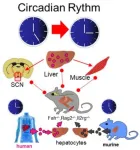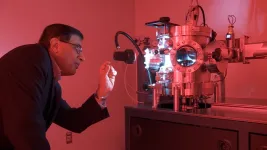(Press-News.org) Researchers at Karolinska Institutet in Sweden have found further evidence for how the Epstein-Barr virus can trigger multiple sclerosis or drive disease progression. A study published in Science Advances shows that some individuals have antibodies against the virus that mistakenly attack a protein in the brain and spinal cord.
The Epstein-Barr virus (EBV) infects most people early in life and then remains in the body, usually without causing symptoms. The link between EBV and the neurological disease multiple sclerosis (MS) was discovered many years ago and has puzzled researchers ever since. Increasing evidence, including two papers published in Science and Nature last year, suggests that EBV infection precedes MS and that antibodies against the virus may be involved. However, the molecular mechanisms seem to vary between patients and remain largely unknown.
“MS is an incredibly complex disease, but our study provides an important piece in the puzzle and could explain why some people develop the disease,” says Olivia Thomas, postdoctoral researcher at the Department of Clinical Neuroscience, Karolinska Institutet and shared first author of the paper. “We have discovered that certain antibodies against the Epstein-Barr virus, which would normally fight the infection, can mistakenly target the brain and spinal cord and cause damage.”
Misdirected antibodies
The researchers analysed blood samples from more than 700 patients with MS and 700 healthy individuals. They found that antibodies that bind to a certain protein in the Epstein-Barr virus, EBNA1, can also bind to a similar protein in the brain and spinal cord called CRYAB, whose role is to prevent protein aggregation during conditions of cellular stress such as inflammation. These misdirected, cross-reactive antibodies may damage the nervous system and cause severe symptoms in MS patients, including problems with balance, mobility and fatigue. The antibodies were present in about 23 percent of MS patients and 7 percent of control individuals.
“This shows that, whilst these antibody responses are not required for disease development, they may be involved in disease in up to a quarter of MS patients,” says Olivia Thomas. “This also demonstrates the high variation between patients, highlighting the need for personalised therapies. Current therapies are effective at reducing relapses in MS but unfortunately, none can prevent disease progression.”
T cells may also be involved
The researchers also found that there is likely a similar cross-reactivity among T cells of the immune system.
“We are now expanding our research to investigate how T cells fight EBV infection and how these immune cells may damage the nervous system in multiple sclerosis and contribute to disease progression,” says Mattias Bronge, affiliated researcher at the Department of Clinical Neuroscience, Karolinska Institutet and shared first author of the paper.
The study was financed by Sweden’s innovation agency Vinnova, the Swedish Research Council, the Swedish Brain Foundation, Karolinska Institutet, MS Forskningsfonden, Neuro, and Region Stockholm. Co-author Hans Grönlund is the inventor of a current patent filed by NEOGAP Therapeutics AB and is the founder and co-owner of this company. Birce Akpinar, Ola B. Nilsson, Erik Holmgren and Guro Gafvelin hold positions at NEOGAP Therapeutics AB. Roland Martin is a co-founder, co-owner and an employee of Cellerys, a spin-out from the University of Zürich, and is a coinventor and patent holder for several patents. Roland Martin and Tomas Olsson have received grants and fees from several companies. See the scientific paper for a complete list of the authors’ potential conflicts of interest.
Fact box: Epstein-Barr virus
The herpesvirus EBV is one of the most widespread viruses in humans. Over 90 percent of the world’s population are infected with EBV and carry the virus for life as a latent, usually asymptomatic, infection. Most people are infected as children with few or no symptoms but in young adults, the virus often causes infectious mononucleosis, also known as glandular fever or kissing disease.
Publication: “Cross-reactive EBNA1 immunity targets alpha-crystallin B and is associated with multiple sclerosis”. Olivia G. Thomas, Mattias Bronge, Katarina Tengvall, Birce Akpinar, Ola B. Nilsson, Erik Holmgren, Tara Hessa, Guro Gafvelin, Mohsen Khademi, Lars Alfredsson, Roland Martin, André Ortlieb Guerreiro-Cacais, Hans Grönlund, Tomas Olsson, Ingrid Kockum. Science Advances, online 17 May 2023, doi: 10.1126/sciadv.adg3032.
END
New study explains how a common virus can cause multiple sclerosis
2023-05-17
ELSE PRESS RELEASES FROM THIS DATE:
Liver cells control our biological clock
2023-05-17
Organisms rely on a biological clock known as the ‘circadian’ clock to regulate their activity according to the time of day. A central clock, constituted by a group of brain cells — the suprachiasmatic nuclei, or SCN — synchronises the circadian clocks present in all body’s organs, called ‘peripheral’ clocks. Until now, synchronisation of the circadian cycle in mammals was thought to be a one-way mechanism in which the suprachiasmatic nuclei alone synchronized the peripheral ...
Adult friendships can triumph over childhood trauma, even in baboons
2023-05-17
DURHAM, N.C. -- Decades of research show that experiencing traumatic things as a child -- such as having an alcoholic parent or growing up in a tumultuous home -- puts you at risk for poorer health and survival later in life.
But mounting evidence suggests that forging strong social relationships can help mitigate these effects. And not just for people, but for our primate cousins, too.
Drawing on 36 years of data, a new study of nearly 200 baboons in southern Kenya finds that adversity early in life can take years off their lifespan, but strong social bonds with other baboons in adulthood can help ...
Using COVID-19 positive donor hearts may impact post-transplant survival
2023-05-17
Heart transplant recipients receiving organs from active COVID-19 positive donors may have an increased risk of death at six months and one year when compared to those receiving organs from recently recovered COVID-19 patients and COVID-19 negative patients, according to a study published today in the Journal of the American College of Cardiology.
“These early trends should be concerning enough such that heart transplantation centers need to thoroughly evaluate and continue to weigh the risks/benefits of using hearts from active COVID-19 donors,” said Shivank Madan, MD, MHA, lead author of the study and a cardiologist ...
Tick tock – the liver controls the circadian clock
2023-05-17
University of Queensland-led research has revealed liver cells influence the body’s internal circadian clock, which was previously believed to be solely controlled by the brain.
Associate Professor Frédéric Gachon from UQ’s Institute for Molecular Bioscience and Dr Serge Luquet from Université Paris Cité/CNRS in France and their collaborators have demonstrated that mice with transplanted human liver cells had modified circadian rhythms.
Dr Gachon said the ...
University of Colorado data scientists develop rare disease phenopacket standard, tools for global use
2023-05-17
Researchers in the Department of Biomedical Informatics (DBMI) at the University of Colorado School of Medicine have reached a major milestone in developing standards and tools for creating phenopackets that may foster more innovation and advancement in the medical field by allowing health professionals to more easily collect and share data.
A newly-released paper highlights the latest suite of coordinated standards and tools used to collect data related to rare diseases.
The phenopackets, ...
Press Release: ECOG-ACRIN announces the recipients of its 2023 scientific leadership and mentorship awards
2023-05-17
The ECOG-ACRIN Cancer Research Group (ECOG-ACRIN) announces the following cancer researchers as the recipients of the organization’s annual scientific leadership and mentorship awards. Through its Mentoring Program, ECOG-ACRIN formally recognizes outstanding scientific leadership through events and awards that identify, encourage, and recognize investigators in the early years of their careers. The program is expanding in 2023 with the addition of the Remarkable Mentor to Women in Oncology Award.
Young Investigator of the Year
Patrick M. Forde, MBBCh, is the 2023 recipient of the Young Investigator Award, a professional honor to recognize ...
UAB will lead an $8 million Department of Energy grant from the National Nuclear Security Administration, or NNSA
2023-05-17
BIRMINGHAM, Ala. – Yogesh Vohra, Ph.D., is the principal investigator of a five-year, $8 million grant from the United States Department of Energy’s National Nuclear Security Administration Stewardship Science Academic Alliances program that supports fundamental research in materials under extreme conditions and in advanced manufacturing.
Vohra, a professor university scholar in the University of Alabama at Birmingham Department of Physics and associate dean in the UAB College of Arts and Sciences, says the grant will leverage the expertise of nine faculty members across five disciplines at UAB and the University of Massachusetts-Amherst, ...
High-res Western drought forecasts could be on horizon
2023-05-17
Contacts:
David Hosansky, NCAR/UCAR Manager of Media Relations
hosansky@ucar.edu
720-470-2073
Ali Branscombe, NCAR/UCAR Communications Specialist
abran@ucar.edu
651-764-9643
A new computer modeling technique developed by scientists at the National Center for Atmospheric Research (NCAR) offers the potential to generate months-ahead summertime drought forecasts across the Western United States with the capability of differentiating between dry conditions at locations just a couple of miles apart.
The technique uses statistical methods and machine learning to analyze key drought indicators during the winter and spring and correlate them with the likelihood of dryness throughout the ...
CCNY researchers use structured light on a chip in another photonics breakthrough
2023-05-17
In everyday life we experience light in one of its simplest forms – optical rays or beams. However, light can exist in much more exotic forms. Thus, even beams can be shaped to take the form of spirals; so-called vortex beams, endowed with unusual properties. Such beams can make dust particles to spin, just like they indeed move along some intangible spirals.
Light modes with such added structure are called “structured,” and even more exotic forms of structured light can be attained in artificial optical materials – metamaterials, where ...
Higher blood sugar linked to faster loss of brain power in stroke survivors
2023-05-17
Surviving a stroke can bring many long-term effects – including a much higher risk of dementia. But a study suggests that blood sugar may play a key role in that risk.
Loss of general thinking ability happened much faster in stroke survivors who had high blood glucose in the years after their health crisis, even after accounting for other things that might affect their brainpower, according to a study published in JAMA Network Open.
Those whose blood pressures or cholesterol were high after their stroke did not lose points on tests of thinking ability, ...




